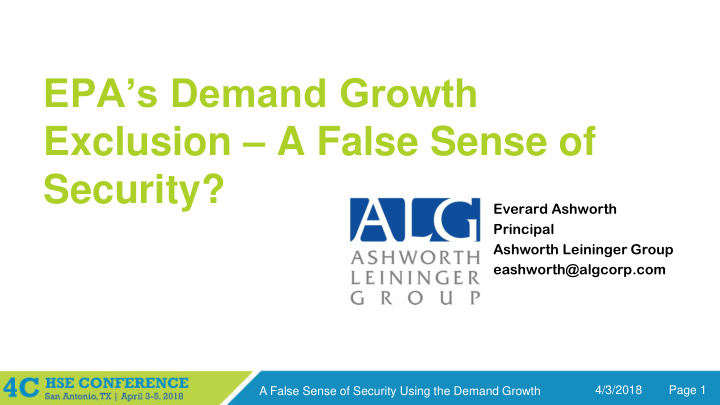



EPA’s Demand Growth Exclusion – A False Sense of Security? Everard Ashworth Principal Bart Leininger, P.E. Ashworth Leininger Group Principal eashworth@algcorp.com Ashworth Leininger Group Camarillo, CA 4/3/2018 Page 1 A False Sense of Security Using the Demand Growth
Objectives • Why is this Topic Important to YOU? • Basics of Capable of Accommodating (COA) and the Demand Growth Exclusion (DGE) • Relevant Guidance in Applying DGE • Practical Application of DGE to Project Permitting Analyses • Summary of Key Points 4/3/2018 Page 2 A False Sense of Security Using the Demand Growth
Why is this Topic Important to YOU? • Securing a PSD permit is time consuming, costly and painful • DGE can be a powerful tool for PSD permit avoidance • Our direct experience indicates that DGE may be widely misapplied/abused • A strong grounding in the DGE principles is essential 4/3/2018 Page 3 A False Sense of Security Using the Demand Growth
The Basics - Terminology • “Could Have Accommodated” / Capable of Accommodating (COA) Level of utilization a unit could have achieved during the consecutive 24-month period (within 10 year baseline) used to establish the baseline period • Demand Growth Exclusion (DGE) Portion of the emissions that is unrelated to your Project and can be excluded DGE is widely misapplied/abused 4/3/2018 Page 4 A False Sense of Security Using the Demand Growth
The Basics - Calculus • Applied at Step 1 of the PSD analysis (Significant Emissions Increase) • Emissions Increase (E) = C – A – D; where: A. Baseline Actual Emissions B. Could Have Accommodated (COA) Emissions C. Projected Actual Emissions D. Demand Growth Emissions (D = B – A) 4/3/2018 Page 5 A False Sense of Security Using the Demand Growth
The Basics – Calculus (cont) 4/3/2018 Page 6 A False Sense of Security Using the Demand Growth
The Basics – Calculus (cont) TPY (NOx) No DGE Using DGE Baseline Emissions A 100 100 COA B 0 150 Projected Emissions C 175 175 DGE D = B - A Not Used 50 Emissions Increase E = C - A - D 75 25 PSD Triggered? Yes No 4/3/2018 Page 7 A False Sense of Security Using the Demand Growth
Relevant Guidance – 2002 NSR Reform “….when a project increase in equipment utilization is in response to a factor such as growth in market demand, you may subtract the emission increase from the unit’s project actual emissions if: (1) The unit could have achieved the necessary level of utilization during the consecutive 24-month period you selected to establish the baseline actual emissions; and (2) the increase is not related to the physical or operational change(s) made to the unit.” 4/3/2018 Page 8 A False Sense of Security Using the Demand Growth
Relevant Guidance – Georgia Pacific Letter* • DGE can only be used for the actual to projected actual test • EPA rejected use of PTE as COA • Highest demonstrated monthly average used as COA in the DGE calculations *EPA Region IV Letter to Mark Robinson, Plant Manager, Georgia-Pacific Wood Products LLC (March 18, 2010) 4/3/2018 Page 9 A False Sense of Security Using the Demand Growth
Relevant Guidance – Recent Court Cases* • Increases in operational uptime resulting from the project are not excludable • Documentation must show that the excluded emissions are unrelated to the project • Non-applicability determination and documentation must be made prior to commencement of construction *US v. DTE Energy Company (Decided January 10, 2017) and US v. Ameren Missouri (Dated January 23, 2017) 4/3/2018 Page 10 A False Sense of Security Using the Demand Growth
Relevant Guidance – 12/7/17 EPA Memo* • The NSR applicability analysis must be prepared prior to construction • Records must be maintained pursuant to the regulations • EPA will not “second guess” the pre -project emissions projections unless there is a clear error • EPA to enforce based on post-project actual emissions recordkeeping *December 7, 2017 Memorandum issued by E. Scott Pruitt to Regional Administrators 4/3/2018 Page 11 A False Sense of Security Using the Demand Growth
Applying the Demand Growth Exclusion • Do I have a defensible basis for a COA that is above the baseline? • Is the highest monthly rate sustainable over the Project? • Would I be better off using highest annual rate to establish COA? • Is my project wholly unrelated to the demand growth? • Does my project improve reliability/uptime? • Would the COA level of activity happen anyway without the project? • Is my project driver independent of demand? 4/3/2018 Page 12 A False Sense of Security Using the Demand Growth
Applying the Demand Growth Exclusion • Examples where DGE can be used • Emissions from affected sources – utilities, cogen, etc. • Modifying a process line to add a new product • Examples where DGE may be hard to apply • Projects designed to provide additional output to meet increased demand • Reliability projects • Capacity increases Difficult, but essential, to separate a project from demand growth 4/3/2018 Page 13 A False Sense of Security Using the Demand Growth
Summary of Key Points • The NSR applicability analysis must be prepared prior to construction • Most projects will likely not qualify for the demand growth exclusion • If demand growth is used in the applicability analysis: • Use a defensible and sustainable basis for the COA • Prepare a detailed analysis showing how the project is unrelated to demand growth • Post-project recordkeeping must demonstrate that PSD is not triggered 4/3/2018 Page 14 A False Sense of Security Using the Demand Growth
Contact Information EVERARD ASHWORTH | PRINCIPAL T: 805.764.6017 | F: 805.764.6011 601 E. Daily Dr. Ste. 302 Camarillo CA 93010 eashworth@algcorp.com | www.algcorp.com 4/3/2018 Page 15 A False Sense of Security Using the Demand Growth
Recommend
More recommend